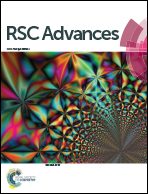Synthesis of polyborosiloxane and its reversible physical crosslinks
Abstract
A hybrid polyborosiloxane was synthesized and the effect of boron concentration on the Si–O : B weak bonding of polyborosiloxane was investigated mainly using FTIR and dynamic rheology. The interaction between boron and oxygen plays an important role on the viscoelastic properties of polyborosiloxane, which forms reversible physical crosslinks through temporary Si–O : B weak bonds splitting and rejoining. Dynamic frequency sweeps and dynamic time sweeps showed frequency-dependent elastic modulus, indicating the presence of a physical network structure in polyborosiloxane. Elastic modulus slowly decreased with a higher temperature owing to the increased chain segment mobility and decreased strength of physical crosslinks. This behavior was believed to be related to the temperature-dependence of Si–O : B weak bonding as also revealed by the FTIR results. Further dynamic mechanical analysis on this behavior showed that elevated temperature tended to increase the motion of the chain segment, resulting in less weak bonding interactions and thereby a weaken network with a lower flat elastic modulus. These results suggest that the reversible physical crosslinks can be regarded as an optional simple way to modulate the viscoelastic properties and to tailor the network structure of silicone rubber mixing with polyborosiloxane that can be used as resilient rubber in practical applications.


 Please wait while we load your content...
Please wait while we load your content...